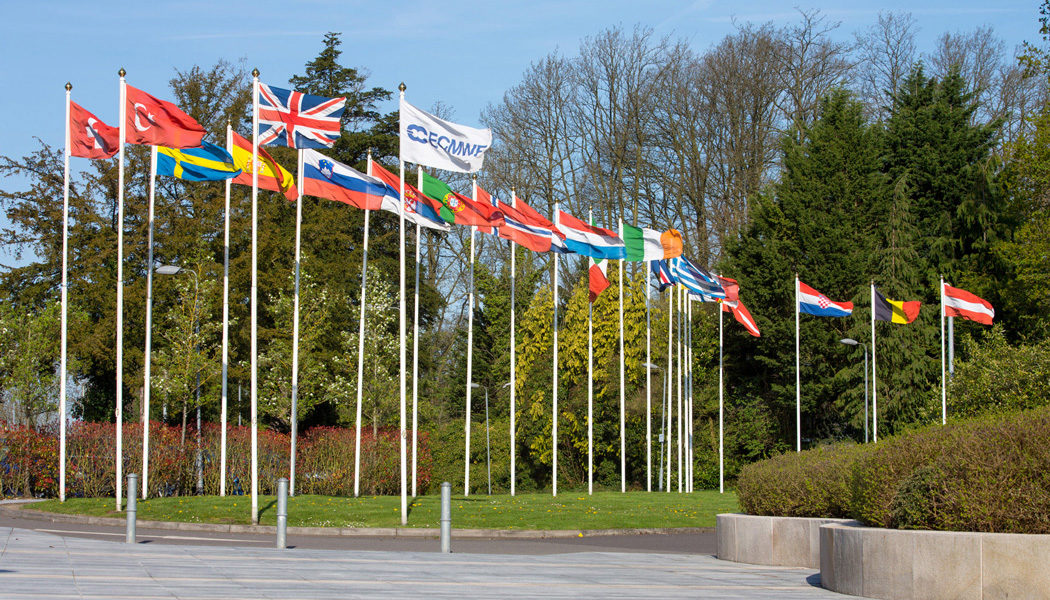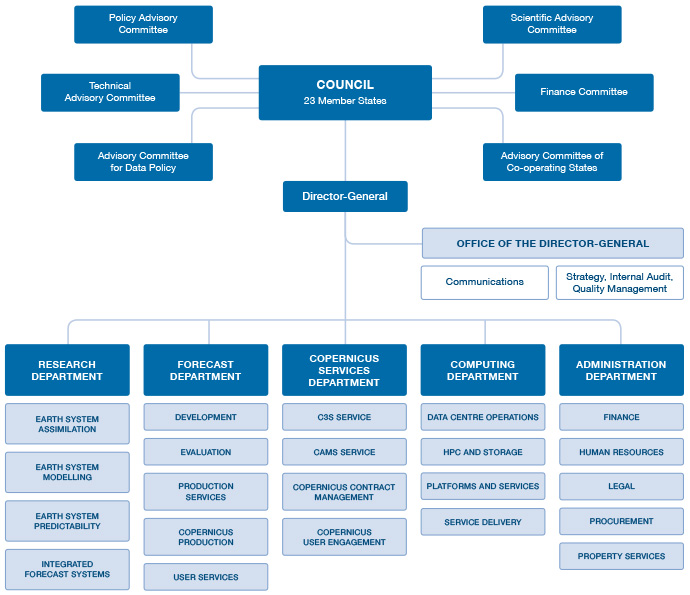The European Centre for Medium-Range Weather Forecasts (ECMWF) is an independent intergovernmental organisation supported by 34 states.
ECMWF is both a research institute and a 24/7 operational service, producing and disseminating numerical weather predictions to its Member States. This data is fully available to the national meteorological services in the Member States. The Centre also offers a catalogue of forecast data that can be purchased by businesses worldwide and other commercial customers. The supercomputer facility (and associated data archive) at ECMWF is one of the largest of its type in Europe and Member States can use 25% of its capacity for their own purposes.

The organisation was established in 1975 and now employs around 360 staff from more than 30 countries. ECMWF is one of the six members of the Co-ordinated Organisations, which also include the North Atlantic Treaty Organisation (NATO), the Council of Europe (CoE), the European Space Agency (ESA), the Organisation for Economic Co-operation and Development (OECD), and the European Organisation for the Exploitation of Meteorological Satellites (EUMETSAT).
ECMWF is based in Reading, UK.

Member States
ECMWF has 23 Member States and 11 Co-operating States
ECMWF's annual budget is funded primarily by annual contributions from the Member and Co-operating States, according to a scale based on their gross national income.

Member States
Austria, Belgium, Croatia, Denmark, Estonia, Finland, France, Germany, Greece, Iceland, Ireland, Italy, Luxembourg, the Netherlands, Norway, Portugal, Serbia, Slovenia, Spain, Sweden, Switzerland, Turkey and the United Kingdom.
Member States are represented in the ECMWF Council, the organisation's governing body.
Co-operating States
Bulgaria, Czech Republic, Hungary, Israel, Latvia, Lithuania, Montenegro, Morocco, North Macedonia, Romania and Slovakia.
Collaboration is central to ECMWF's work
Member and Co-operating States receive ECMWF's numerical prediction data in real time to prepare forecasts for their end users. They can access ECMWF's basic computing facilities, the meteorological archive, and temporary tape storage. Member States also have access to the supercomputers and permanent tape storage.
ECMWF works in collaboration with national meteorological and hydrological services and research institutions from many of the Member and Co-operating States, to develop its modelling capabilities, to design new products and to evaluate and diagnose forecast quality.
Read more about how international collaboration serves meteorology.
History
ECMWF was established in 1975. Its purpose – then as now – was to pool Europe's meteorological resources to produce accurate climate data and medium-range forecasts.



The project was created by COST (European Cooperation in Science and Technology), which supported co-operation between scientists and technicians in Europe. The UK won a bid to host the Centre, thanks to the proximity of its proposed site to the UK Met Office and the University of Reading.
1971-1975: Convention established
The first draft of the ECMWF Convention was considered on 9 and 10 December 1971, with 32 senior representatives from 14 of the 18 founding States attending. The Convention was signed in 1973 and came into force on 1 November 1975.
Its creation set up the centre as an independent intergovernmental organisation.
1979: First forecasts produced
The first real-time medium-range forecasts were made in June 1979, and ECMWF has been producing operational medium-range weather forecasts since 1 August 1979. At first, forecasts were made five days a week. From 1 August 1980, they were made seven days a week.
The first ensemble predictions, produced as part of the operational forecasting system, were achieved on 24 November 1992.


2005-2010: New Members allowed to join
In 2005, the Convention was amended to allow new Member States to join the organisation, with the amendments coming into force in 2010.
Yearly progress
Since then, ECMWF has continued to develop and improve. Progress over the years has included beginning to monitor the Earth-system, installation of a new supercomputer, upgrades to the forecasting model and contributions to climate studies.
For more details on our yearly progress, please browse the Annual Reports in our Media resources.
Key Facts & Figures
Background
- 23 Member States and 11 Co-operating States.
- About 370 employees from over 30 countries.
- Established in 1975.
- Find out more on our History page and timeline.
Finance
- The Member and Co-operating States of ECMWF are the principal source of finance for the Centre, with contributions totalling £48 million in 2019.
- External organisations support both core research and the complementary goals of the Centre. In 2019 their funding totalled £54.7 million, while revenue from sales of data and products provided additional income of over £10.2 million.
- The sponsorship department in the UK Government for ECMWF is the Department for Business, Energy and Industrial Strategy (BEIS).
Forecasts
- The term 'medium range' refers to time periods up to about 2 weeks ahead. Extended forecasts are also produced for monthly and seasonal timescales.
- The weather services of ECMWF Member States receive ECMWF's numerical weather prediction data in real time – 24 hours a day, 7 days a week.
- Forecasts are produced four times per day for weather services and commercial customers.
- Commercial licences are held by customers in over 30 countries.
- ECMWF uses advanced computer modelling techniques to analyse observations and predict future weather.
- ECMWF routinely processes data from around 90 satellite instruments as part of its operational daily data assimilation and monitoring activities. We receive 800 million observations daily, and 70 million quality-controlled observations are available daily for use in the Integrated Forecasting System (IFS); the vast majority of these are satellite measurements, but ECMWF also benefits from all available observations from non-satellite sources, including surface-based and aircraft reports.
Research
- ECMWF has research partnerships with national meteorological services of the Member States and Co-operating States.
- We also carry out a number of research projects coordinated and financed through the European Union, European space agencies and national funding sources.
Supercomputing
- ECMWF's supercomputers are among the largest of their type in Europe.
- Our supercomputers operate with a sustained speed of more than 330 trillion floating point operations per second (330 teraflops).
- Our supercomputers serve a variety of purposes, with 50% capacity used for research, 25% used by Member States and 25% used for production of operational forecasts.
- The ECMWF meteorological data archive (MARS) is the largest in the world and continues to grow. As of November 2020, it contains around 270 petabytes of operational and research data, with about 200 terabytes being added daily. More than 400 billion meteorological fields are stored in MARS.







































